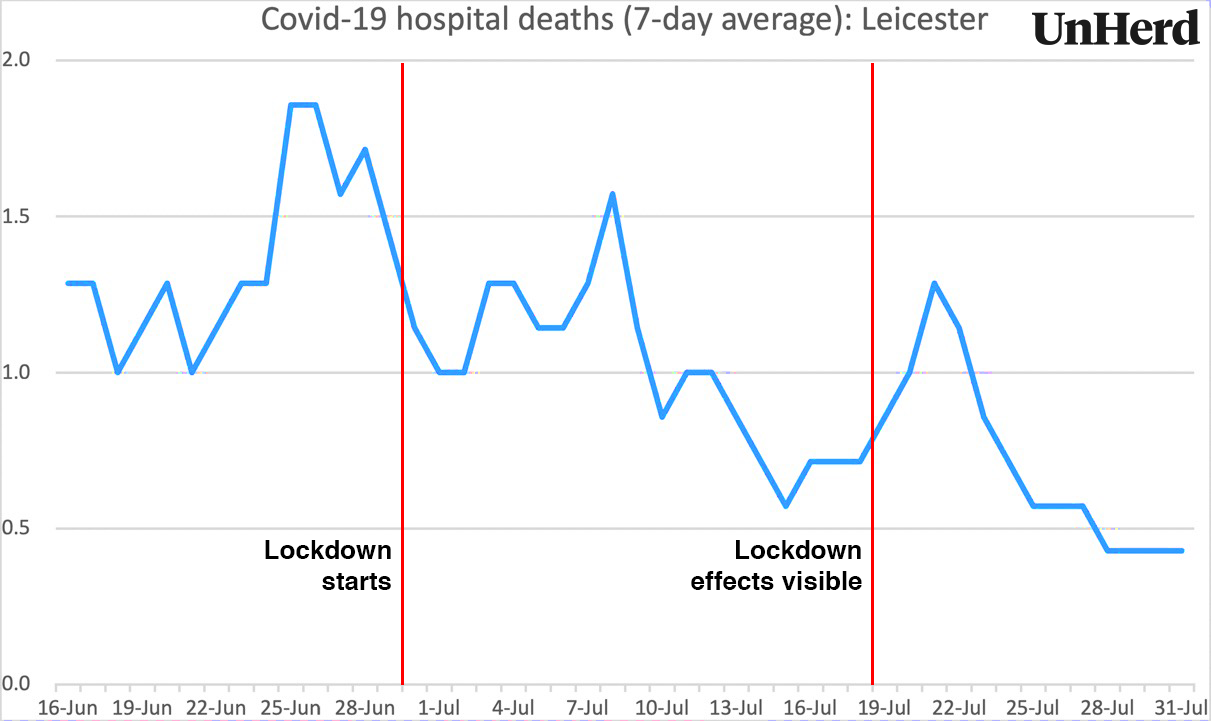Every time there is an increase in coronavirus cases in a local area, a local lockdown now seems to be on the cards: Matt Hancock announced new restrictions last week affecting over 4 million people in Lancashire and Yorkshire, and just yesterday the Scottish government announced a local lockdown in Aberdeen.
But do they actually serve any purpose, other than being seriously damaging to local businesses and the community? One month on from the first such lockdown in Leicester, we now have enough data to make an assessment.
Given what we know from the new cases data and other measures such as NHS 111 Triage data, infections in Leicester had been increasing steadily from the start of June. During that month, testing was ramped up around the city and track and trace measures implemented. Valid concerns were raised by Leicester’s Mayor that data was slow to get through to local officials but the evidence suggests that these track and trace measures were having an effect prior to the local lockdown.
Matt Hancock announced the new lockdown measures for Leicester would start from Tuesday 30th June. Note though that, given a 5-7 day period before symptoms develop, the earliest time at which we could observe any effect of the new lockdown measures in new cases data would be about the 5th July.
The graph shows the development of new cases by test date using the 7-day average (as testing is subject to day-of-the-week effects). New cases peaked on the 24 June implying infections peaked 5-7 days earlier, at least 10 days before the new lockdown was even announced. By the 4th July, still before lockdown could have shown any impact, new cases were down by 28%.

Quite a few new cases were found from tests on 5th & 6th July meaning the average ticked up a little. Although it might be tempting to suggest that uptick was caused by the lockdown itself, more likely it simply reflected the intensive testing efforts going on. In any case, it is clear that infections were decreasing well before the lockdown measures were announced, a conclusion backed up by the NHS 111 triage data.
Of course the real concern with outbreaks is that really serious cases will result in hospitalisation or even death. Local hospitalisation figures are not publicly available but the Public Health England Rapid Investigation Team report on 29th June 2020 confirmed that admissions had “remained steady at between 6 and 10 new COVID-19 confirmed admissions per day over the last 4 weeks.” In other words, at the time Matt Hancock made his announcement, there was no indication that local health services were likely to be overwhelmed; and they never became remotely so, despite the terrifying-looking charts showing surges of new cases. (As Freddie Sayers pointed out on these pages at the time, most of those new cases were young people).
Deaths are a lagging indicator, happening on average perhaps 20 days after infection. The 7-day average for Leicester hospitals did increase to just under 2 deaths per day by 24th June. Deaths then decreased from the 26th June (albeit with some fits and starts) to an average well below 1 death per day by the end of July.
Rather like case numbers, the situation (which never looked like reaching disaster levels) was improving well before the local lockdown could possibly have had an effect.

It is impossible entirely to exclude the possibility that the local lockdown helped cases come down faster than would otherwise have been the case, though there is little indication of that in the data. What we can say with some certainty is that the lockdown restrictions were not required to get the situation in Leicester under control.
The testing and tracing measures seem to have been enough on their own to get infections down, despite the well-publicised problems with getting enough detailed data to local health teams. Assuming there have since been improvements to the track and trace system, we should be even more confident that future outbreaks can be managed in this way, without resorting to lockdowns.
A generous reading of Matt Hancock’s decision to enforce the local lockdown is that, at the time of the announcement, he may have been uncertain that infections were already coming down and so the measures were precautionary. You might forgive that mistake once, but it is important now that the Government looks at the evidence and learns its lesson. The right response to local outbreaks and spikes should be testing, information and advice and not the imposition of costly legal restrictions.










Join the discussion
Join like minded readers that support our journalism by becoming a paid subscriber
To join the discussion in the comments, become a paid subscriber.
Join like minded readers that support our journalism, read unlimited articles and enjoy other subscriber-only benefits.
Subscribe